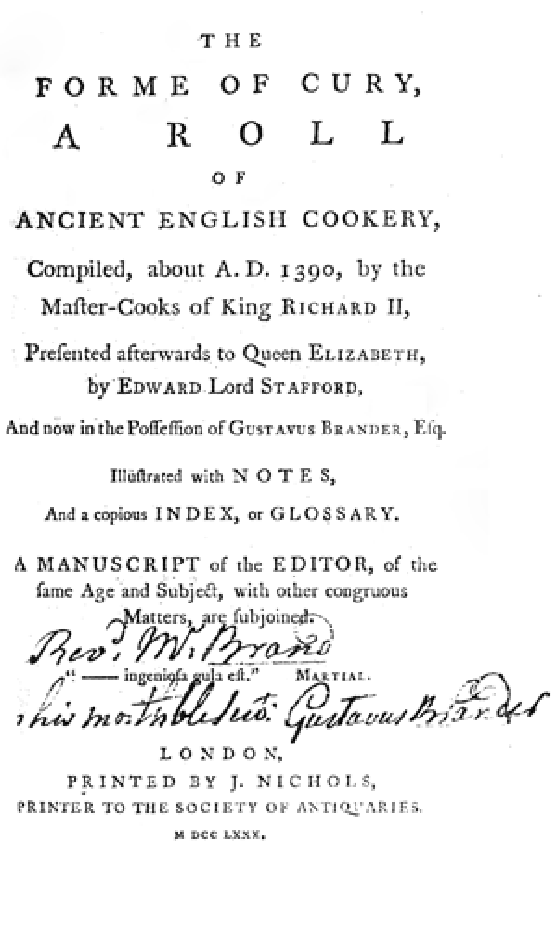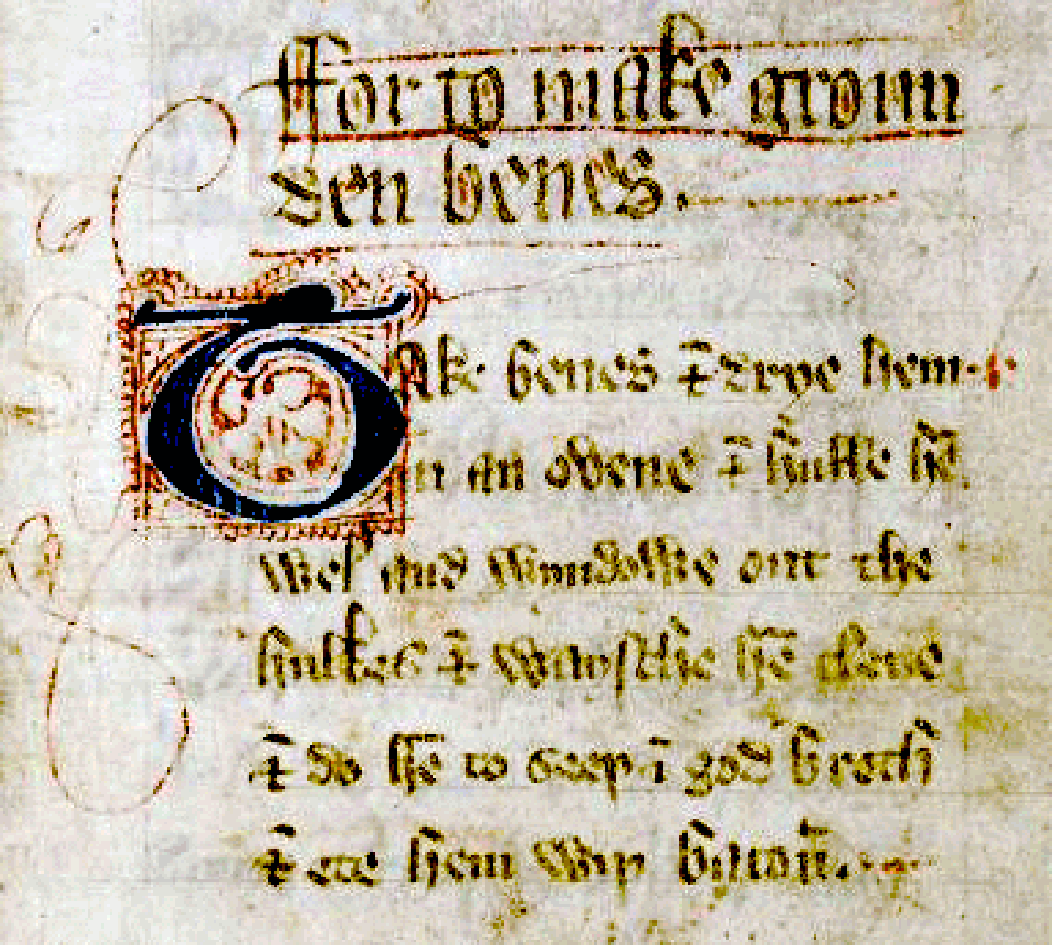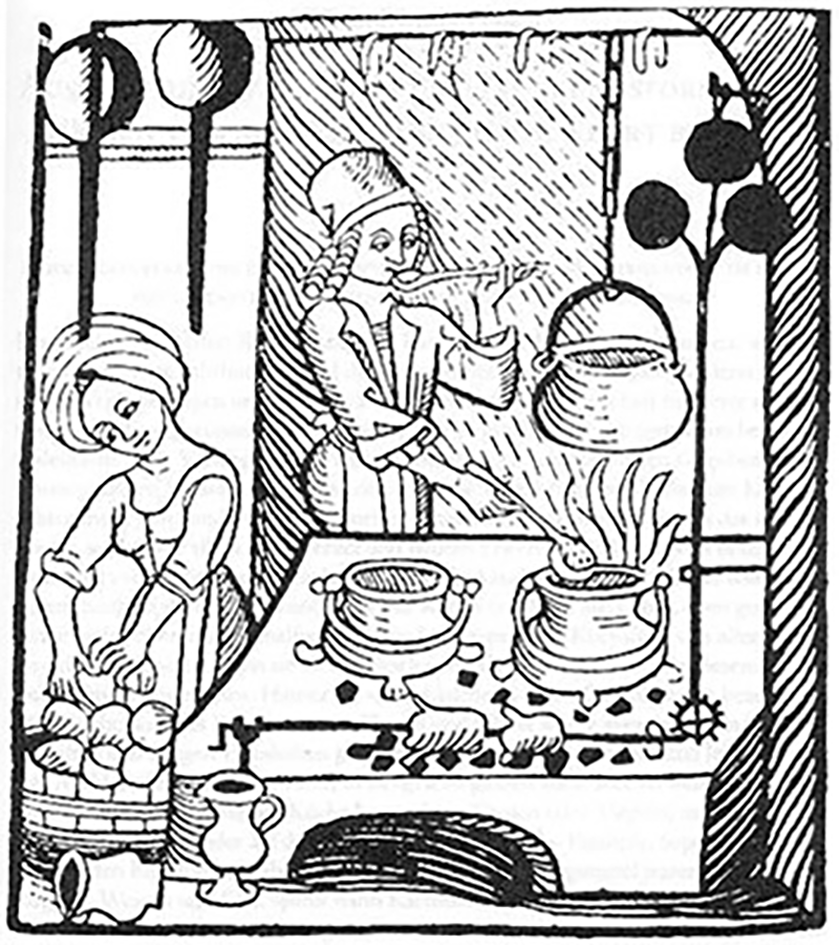FabulousFusionFood's The Forme of Cury Medieval Recipes and Information Home Page
 The image above shows the frontispiece to the 1791 edition of the
The image above shows the frontispiece to the 1791 edition of theForme of Cury by Samuel Pegge.
Welcome to FabulousFusionFood's The Forme of Cury (The Method of Cookery) Recipes and Modern Redaction Recipes Page — This page brings together all the recipes on this site redacted (updated) from the 1390 Medieval Manuscript The Forme of Cury (The [Proper] Method of Cookery). All recipes are given both in their original Middle English form, as updated English versions and as a modern redaction that and cook today could follow so that you, too, can prepare classic Georgian fare at home. Below I also provide a brief history of the manuscript. I am making my way through the entire recipe collection and as soon as they are added to my site they will be available here. (For the recipe list scroll down.) Enjoy...
Note that this page provides an introduction to the Forme of Cury text, as well as links to all the recipes that have been redacted in modern version to allow you to prepare them at home. The entire text of the Forme of Cury is also given with a parallel modern English rendition of all the recipes. For the text of the Forme of Cury itself, either use the links on the left, or scroll down to the Table of Contents, below.
For the complete list of recipes, please scroll down to the 'links to The Forme of Cury recipes' below.
The Forme of Cury (The [Proper] Method of Cookery)
The Forme of Cury This represents the earliest recipe collection in English. The original version seems to have been a roll dating to the late 14th century (circa 1377 to 1391), attributed to the chief master cooks of King Richard II. Various versions exist, though it seems that two copies 'A' and 'B' were made from an original version.The 'B' version, as exemplified by the University of Manchester's English MS 7 (containing 194 recipes and bound in book form and dating from about 1420), held in the John Rylands Library and British Library Additional MS 5016 (containing 196 recipes), which is the version copied by Pegge.
It is likely that the recipes were dictated by the Master Chefs of the royal household to scribes as the dishes were prepared. It should be remembered that the master chefs of Medieval kitchens were more like circus ringmasters than modern chefs, in that they directed proceedings as the meal was prepared, rather than being directly involved in the food preparation themselves.
The name Forme of Cury was the name given by Samuel Pegge to the entire collection of recipes. And though this phraseology does occur in the MSS it is not known what the roll was originally called.
The Forme of Cury is the first book solely about recipes and cookery written in the English language. As a result, it's an important volume to food historians, all those interested in cookery and in those interested in the origins of the English language itself. As a result I have taken it upon myself to present the original text, along with an update of the text to modern English and modern redactions of the recipes that anyone can cook at home. Like Apicius's De Re Coquinaria (the only surviving Ancient Roman recipe book) the Forme of Cury is of such importance that it simply had to be presented in its entirety here.
The word cury in the book's title is the Middle English word for 'cookery' and it is totally unrelated to the modern term 'curry', which derives from the Tamil for 'sauce'.
 The image above shows the text for the first recipe from The Forme
The image above shows the text for the first recipe from The Formeof Cury: For to Make Gronnden Beans as found in the
Rylands Library manuscript version of the text. [For a
typeset version of the same text, see below.]
This is the first time that the entire volume has been presented on the web, and it comes with a side-by-side modern English version. I am also working on redacting all the recipes for the modern cook so that they will be presented in a form that a modern cook can follow to re-create traditional Medieval dishes.
The version presented here is a diplomatic version based on Samuel Pegge's 1791 version (the Frontispiece of which is shown above) and the University of Manchester's manuscript (images of which are on the web). A single recipe, from the Rylands Manuscript, the first recipe in the collection For to make gronnden benes is shown to the immediate left of this page, so you can see the handwritten form of the original.
It's this site's aim to provide the original text of all the recipes in The Forme of Cury along with updates to modern English and to provide the modern cook with a current redaction of the recipe. You can also find more recipes from the Medieval period in this site's Medieval recipes page.
Though the Forme of Cury is an invaluable document, both in terms of the evolution of modern English (it's one of the few surviving examples of early middle English) and the evolution of English cuisine from Norman-French origins, it must be remembered that the Forme of Cury represents court cookery and not the food of the common people.
That caveat being said, the preamble to the Forme of Cury does state that the roll is intended to show how to prepare common dishes and there are a mix of more ordinary pottages and dishes as well as expensive and elaborate courtly ones. Indeed, comparison of The Forme of Cury with the French Villandier de Trevaillant shows a considerable overlap so, a critical examination of The Forme of Cury will reveal details about the more homely dishes and diets of the medieval age.
 The image above shows a woodcut of a man and a woman in
The image above shows a woodcut of a man and a woman inperiod costume cooking in a medieval kitchen.
ffor to make gronnꝺen benes·
Ꞇa benes +̅ ꝺrye hem in an oỽene +̅ ulle ē wel anꝺ wynꝺowe out ꞇe hule +̅ waye hē clene +̅ ꝺo ē clene +̅ ꝺo hē ꞇo seeþ ī goꝺ broꞇ +̅ eꞇe hem wiþ baco.
The result of this may be a little difficult to read for those used to modern fonts and orthography, however, the handwritten texts do have a beauty all their own and I think that should be honoured as much as possible using modern fonts. As this site also gives a modern update of the recipe in parallel with the original (there are also links to modern versions of the recipe that you can prepare at home) it will be possible for you to get used to the medieval text by comparing the original words with the modern equivalent.
On the top right navigation menu you will find links to each and every section of The Form of Cury (the original was a single roll and has been broken down here for easier navigation), or you can go directly to the table of contents.
The alphabetical list of all the recipes derived from the Forme of Cury on this site follows, (limited to 100 recipes per page). There are 182 recipes in total:
Page 1 of 2
| Appulmoy (Apple Stew) Origin: England | Chyryse Origin: England | Fonnell Origin: England |
| Aquapatys Origin: England | Chysanne (A Dish to be Eaten Cold) Origin: England | For to boyle feasant partrychs capons and corlowe (How to Boil Peasant, Partridges, Capons and Curlews) Origin: England |
| Balloc Broth Origin: England | Clarrey (Claret) Origin: England | For to make blank manger (To Make White Food) Origin: England |
| Benes y Fryed (Medieval Fried Beans) Origin: England | Clate Origin: England | For to make flampens (To Make Pasta Pies) Origin: England |
| Blank Desne (White Desire) Origin: England | Cold Bruet (Cold Brewet) Origin: England | For to make noumbles in lent (Stewed Fish Intestines for Lent) Origin: England |
| Blank dessore (White Desire) Origin: England | Comadore (Fruit Pie Delicacies) Origin: England | For to make pomme doryes and other thyngs (How to Make Golden Apples and Other Things) Origin: England |
| Blank Maunger Origin: England | Comarye Origin: England | Frumente (Wheat in Milk and Broth) Origin: England |
| Brewet of Almayn (Bruet of Almonds) Origin: England | Comarye (Roast Pork Marinated in Red Wine) Origin: England | Frytor of pastronakes of skyrwyts and of apples (Fritters of Parsnips, Skirrets and of Apples) Origin: England |
| Brewet of Ayrenn (Scrambled Eggs) Origin: England | Compost Origin: England | Frytour Blaunched (White Fritters) Origin: England |
| Bukkeande Origin: England | Conger in sawce (Conger Eels in Sauce) Origin: England | Frytour of Erebes (Herb Fritters) Origin: England |
| Bursen Origin: England | Connates Origin: England | Frytour of Mylke (Milk Fritters) Origin: England |
| Burseu (A Dish of Minced Meat) Origin: England | Connynges in Clere Broth (Rabbits in Clear Broth) Origin: England | Frytour of mylke II (Milk Fritters II) Origin: England |
| Bursews Origin: England | Connynges in Syrup (Rabbits in Syrup) Origin: England | Frytour of Pasturnakes (Parsnip Fritters) Origin: England |
| Caboches in Potage (Cabbage Stew) Origin: England | Conynges in Cynee (Rabbits in Blood and Vinegar Broth with Onion) Origin: England | Funges (Mushrooms) Origin: England |
| Capons in Concy (Capons in Confit) Origin: England | Conynges in Gravey (Rabbits in Gravy) Origin: England | Furmente with porpays (Grain Pottage with Porpoise) Origin: England |
| Capons in Concy II (Chicken in Bread-thickened Stock with Eggs) Origin: England | Corate Origin: England | Fygey (Figgy Pottage) Origin: England |
| Carnel of Pork (Pork Flesh) Origin: England | Corate II Origin: England | Fyletes in galyntyne (Fillets in a Sauce of Meat Juices) Origin: England |
| Caudel Ferry (Caudle Ferry) Origin: England | Cotagrys (Cockatrice) Origin: England | Fyletus in Galentyne (Fillets in a Sauce of Meat Juices) Origin: England |
| Caudel for gees (Caudle for Geese) Origin: England | Creme of almanndes (Cream of Almonds) Origin: England | Galintine (Galantyne) Origin: England |
| Caudel of almannd mylke (Caudle of Almond Milk) Origin: England | Crustardes of Flessh Origin: England | Gees in hoggepot (Hodge-podge of Geese) Origin: England |
| Caudel of Muskels (Caudle of Mussels) Origin: England | Cruton (Savoury Custard) Origin: England | Gelee of fleche (Meat in Jelly) Origin: England |
| Cawdel of Samoun (Caudle of Salmon) Origin: England | Daryols Origin: England | Gelee of fysche (Fish in Jelly) Origin: England |
| Charlet Origin: England | Drawen Benes (Mixed Beans) Origin: England | Gourdes in Potage (Pottage of Gourd) Origin: England |
| Charlet Yforced (Meat Charlet) Origin: England | Drepee (Small Birds in Almond Milk) Origin: England | Grewel Forced (Meat Gruel) Origin: England |
| Chastletes (Little Castles) Origin: England | Egredouce (Meat in Sweet and Sour Sauce) Origin: England | Gronden Benes (Ground Beans) Origin: England |
| Chaudyn for swanns (Swan with Entrail Sauce) Origin: England | Egredouce of fysche (Fish in Sweet and Sour Sauce) Origin: England | Gruel of almanndes (Gruel of Almonds) Origin: England |
| Chewetts of flesh day (Chewetts for Flesh Days) Origin: England | Elys in Brewet (Eels in Bruet) Origin: England | Gyngenes (Ginger Sauce) Origin: England |
| Chewetts on fysche day (Chewetts for Fish Days) Origin: England | Eowtes of Flessh (Herbs Like Flesh) Origin: England | Gyngens (Ginger Sauce) Origin: England |
| Chycches (Vetches) Origin: England | Erbolat Origin: England | Gynggaudy Origin: England |
| Chyches (Roast Chickpeas) Origin: England | Erbowle Origin: England | Hares in Papdele (Hare Stew on a Bread Base) Origin: England |
| Chyckenys in Caudel (Chickens in Caudle) Origin: England | Fenkel in Soppes (Fennel in Sauce) Origin: England | Hares in Talbotes (Hares in Hare-blood Sauce) Origin: England |
| Chykenes in Grauey (Chickens in Gravy) Origin: England | Filetes in galyntyne Origin: England | Hart rows Origin: England |
| Chykenes in Gravey (Chicken in Gravy) Origin: England | Flampoyntes (Flan Points) Origin: England | |
| Chykenys in hocchee (Stuffed Chickens Cooked in Broth) Origin: England | Flaumpens Origin: England |
Page 1 of 2